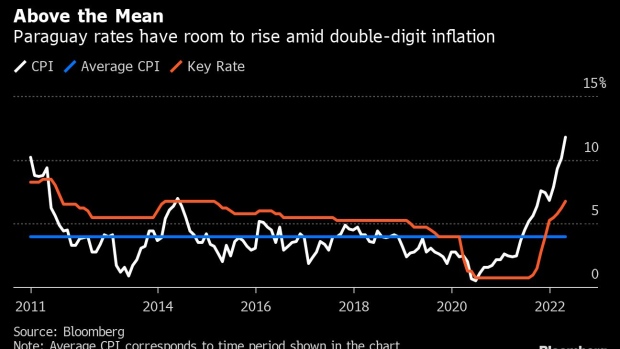May 5, 2022
Inflation Spike Pressures Paraguay Central Bank to Boost Rates
, Bloomberg News

(Bloomberg) -- Paraguay’s central bank is prepared to keep raising borrowing costs if the biggest surge in consumer prices in almost 14 years further erodes inflation expectations, according to a senior policy maker.
The central bank has lifted its benchmark interest rate by 600 basis points to 6.75% since the start of its tightening cycle in August. Rising food and imported fuel prices sent inflation soaring 11.8% last month, almost three times the central bank’s 4% target and one of the highest in the region.
Future interest rate increases might be smaller than the 50 basis-point hikes in recent policy meetings, said Humberto Colman, a member of the central bank’s board of directors.
“We haven’t had an increase in inflation like this since we adopted inflation targeting in 2011,” Colman said in an interview from Asuncion. “It’s an important challenge for monetary policy.”
Like most economies around the world, the South American nation was already battling rising consumer prices from the pandemic recovery when Russia’s invasion of Ukraine increased the inflationary pressures. A deep drought early in the year not only aggravated food inflation, but led the central bank to slash its growth forecast for 2022 to almost zero due to the worst soy harvest in two decades.
Inflation probably won’t peak until the second half of the year before slowing to 8.2% in December, central bank chief economist Miguel Mora said during the same interview. Medium-term inflation expectations have started to deteriorate, with an April survey of analysts by the central bank forecasting 4.6% inflation in 18 to 24 months, up from 4% in December.
“What is happening with expectations concerns us a lot because it’s an important price setting factor,” Mora said. “Our monetary policy addresses that concern: aligning expectations again.”
FX Intervention
The guarani appreciated 0.7% against the U.S. dollar this year amid higher local interest rates and central bank intervention in the currency market. The monetary authority made discretionary dollar sales of almost $342 million in the first four months of the year, compared to $355 million for all of 2021.
With its intervention, the central bank sought to mitigate volatility from the war in Ukraine, the interest rate outlook in the U.S. and market expectations that a bad soy harvest would reduce dollar inflows, Mora said.
“It appeared opportune to keep the exchange rate relatively stable during that period” until volatility eased, he said. “Going forward we are going to respect market fundamentals.”
Other key points from the interview:
- The central bank has put in place a task force to study the regulation of digital assets including cryptocurrencies in Latin America, Colman said
- The central bank is not expecting to publish regulations for digital assets this year, he said
- The task force is also evaluating the creation of a central bank issued digital currency, or CBDC, to encourage financial inclusion
- ”This might accelerate next year into a proposal. It’s too early to say. I think we are going to take a little more time to have a concrete proposal” for a CBDC, Colman said
©2022 Bloomberg L.P.





